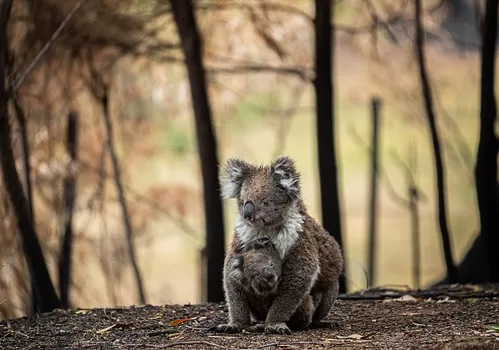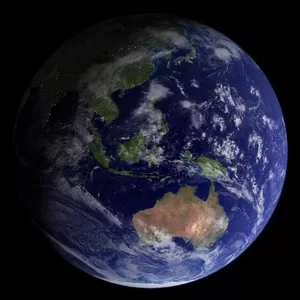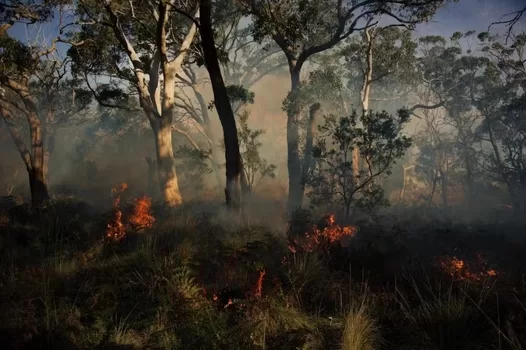The catastrophic 2019-2020 Black Summer bushfires has been a wake up call to the vulnerable state of the ecology which is being actively managed by man. Business as usual doesn’t seem to be working for the animals and forests, and even the cattle farmers responsible for the majority of deforestation, are not happy with existing laws.
Photo credit: Koala & joey – We Animals Media. Story continues below our advertising:
Defending the Unburnt
Environmental Defenders Office (EDO) and the World Wide Fund for Nature-Australia (WWF-Australia) have embarked on a bold mission to aid nature’s recovery.
The “Defending the Unburnt” initiative aims to safeguard six key areas along the east coast that served as crucial havens for endangered flora, fauna, and ecosystems in the aftermath of the country’s most devastating fires on record.
“Australia has already lost 104 species to extinction and just over 2000 more are listed as threatened with extinction under the EPBC Act,” EDO Special Counsel Cerin Loane said.
“Australia remains a global leader in biodiversity loss. Improvements to national environment laws could turn this around – but we are still waiting to see where they land,” Cerin Loane said.
Bushfires, Bureaucracy, and Barriers
Initially optimistic about utilizing existing legal frameworks to achieve their objectives, WWF-Australia’s Head of Evaluation and Science, Romola Stewart, soon encountered a harsh reality.
“How wrong we were. What we encountered were barriers and bureaucracy. The laws are ineffective or woefully underused,” Romola Stewart said.
The resulting report, “Bushfires, Bureaucracy, and Barriers,” jointly launched by WWF-Australia and EDO, exposes a series of critical shortcomings in national and state habitat protection laws:
Lack of Mandatory Habitat Identification: The report highlights the absence of mandatory requirements for identifying critical habitat.
Unclear Definition of Critical Habitat: Existing laws fail to clearly define what constitutes critical habitat, leading to ambiguity and inconsistency.
Limited Protections: Protections for critical habitat are inadequate and insufficient across Australian jurisdictions.
Procedural Barriers: Complex procedural requirements and bureaucratic processes create significant barriers to effective habitat protection.
Underutilization of Critical Habitat Provisions: Despite existing provisions, critical habitat mechanisms are vastly underused.
Incentive Gap for Private Land Protection: The failure to incentivize the protection of critical habitat on private land has contributed to the underutilization of available mechanisms.
Australian state & federal government failures
The report further delves into the specific failures observed in various federal and state government jurisdictions:
Commonwealth: Over the past two decades, no new areas have been added to the register of critical habitat under the Environmental Protection and Biodiversity Conservation Act 1999 (EPBC Act), despite substantial data warranting such listings.
Queensland: Although Queensland’s Nature Conservation Act 1992 includes provisions for identifying and protecting critical habitat, these mechanisms have never been utilized since the Act’s inception 32 years ago. Queensland leads Australia in deforestation.
New South Wales: The NSW Biodiversity Conservation Act 2016 offers provisions to safeguard areas of outstanding biodiversity value (AOBVs), yet no new AOBVs have been declared since the Act’s commencement. Landholder support is a prerequisite for nomination, posing a significant obstacle. Additionally, while the Saving Our Species (SoS) program engages with landowners potentially possessing critical habitat, it does not ensure permanent protection.
Victoria: Despite being in force for over three decades, the Victorian Flora and Fauna Guarantee Act 1988 has only been invoked twice to protect critical habitat, with subsequent withdrawals of those protections. Recent amendments to the Act have failed to yield any new critical habitat determinations.
The report underscores the urgent need for comprehensive reform to address the systemic failures plaguing habitat protection laws. Only through decisive action can we ensure the preservation and restoration of our invaluable natural heritage for generations to come.
Australia is a world’s leader in deforestation
Australia stands as a key battleground for global deforestation, ranking alongside Borneo, the Amazon, and the Congo. Australia holds the dubious distinction of having the highest rate of mammal extinctions worldwide.
Average deforestation in hectares, 2015-2020
| 1. Brazil, South America | 1,695,700 | 11. Colombia, South America | 199,230 | |
| 2. India, Asia | 668,400 | 12. South Africa, Africa | 199,000 | |
| 3. Indonesia, Asia | 650,000 | 13. Zambia, Africa | 189,710 | |
| 4. Tanzania, Africa | 474,000 | 14. Peru, South America | 179,090 | |
| 5. Australia, Oceania | 416,840 | 15. Mexico, North America | 165,820 | |
| 6. Myanmar, Asia | 293,920 | 16. Nigeria, Africa | 163,310 | |
| 7. Paraguay, South America | 279,340 | 17. Argentina, South America | 134,800 | |
| 8. Mozambique, Africa | 267,030 | 18. China, Asia | 133,200 | |
| 9. Sudan, Africa | 264,000 | 19. Venezuela, South America | 108,920 | |
| 10. Bolivia, South America | 242,540 | 20. Nicaragua, South America | 105,030 |
Between 2001 and 2023, Australia witnessed a staggering loss of 9.04 million hectares of tree cover, mostly for beef production. This represents a significant 21% decrease in tree cover since the turn of the century, accompanied by the emission of 2.24 gigatons of CO₂ equivalent.
Between 2000 and 2017, the losses encompassed over 7.7 million hectares, which are presumed to have served as habitat for threatened species.
Between 2000 and 2020, Australia saw a net change of -917 thousand hectares, representing a decrease of 1.0% in overall tree cover.
Data on net forest change, afforestation and deforestation is sourced from the UN Food and Agriculture Organization’s Forest Resources Assessment.
Related stories
Biodiversity Appreciation: Insights from the Community
Forestry Corp Admits Guilt Destroyed Vital Trees
The Battle for Wild Cattle Creek State Forest
Illegal Logging in Styx River State Forest Must Stop
MPs $64,000 question – Save Koalas or logging trucks
NSW Forestry Corp fines exceed $1,000,000 since 2019 fires
Forestry Corp NSW forms a special police branch
Citizen Scientists Take Action in Bulga State Forest
Logging Threatens Koala Habitat Despite Community’s Pleas
EPA stops logging at Flat Rock State Forest
EPA’s Stop Work Order extended in Tallaganda State Forest
Greater Glider heading for extinction
NSW Forestry Corp have a fight on their hands to Save Bulga Forest
Midcoast Council Votes to Save Bulga Forest on Biripi Country
The Great Koala National Park without any Koalas
Is AUKUS damaging Australia’s relationship with China?
Era of Change: 1960s-70s Revolution & Welcome to Country
Please comment below or visit our advertisers, if this is interesting to you. ChatGPT assisted. Thanks for visiting our growing magazine.




